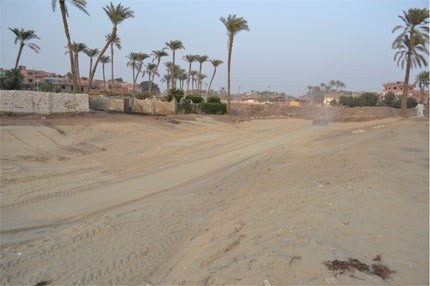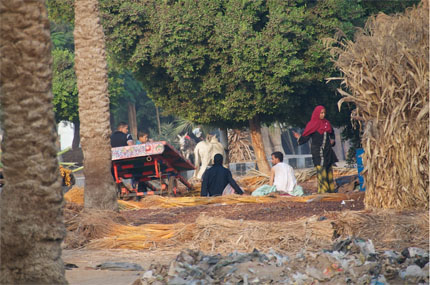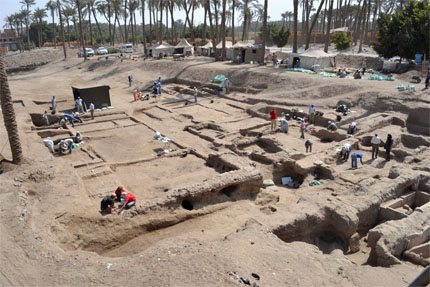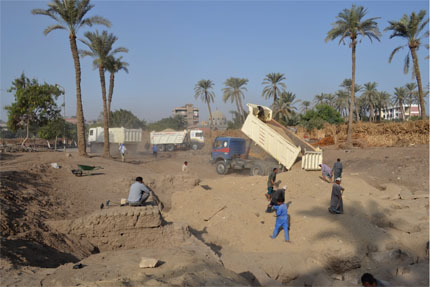Posted by Ana Tavares, Field School Co-Director
After an intense eight weeks of excavation, we reached the end of the Mit Rahina field school. So, just like the palm date pickers at the end of the harvest season, we move on…
In August, the date pickers set up their reeds enclosures in the ruin field of Memphis for the harvest season. These simple, rectangular enclosures are built entirely of reeds with palm logs uprights. They are open and have one single entrance with a reed screen for privacy. Inside, the whole area, open to the skies, is spread with reed mats, on which different types of dates are drying. Sun ripening the dates draws out the sugar and makes for a beautiful patch work of colors: from yellow, through orange to dark red and rich brown.
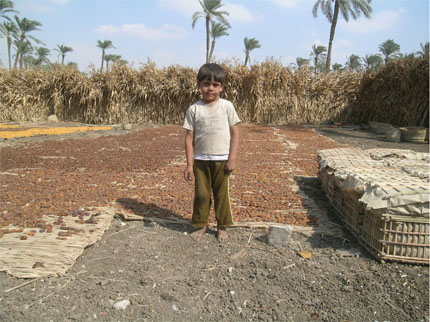
Our neighbours: a small boy inside the reed enclosure, where his family dry dates and lives during the harvest season. Photo by Saied Talbeah.
Each family and household animals (often one water buffalo (gamousa), one horse or donkey, one or two goats and sheep) lives for a few months in the enclosure; the children scampering around, the women cooking and living inside, the men sleeping across the entrance wrapped in blankets.
In late October, at the end of the season, when the dates have ripened and have been sold, the whole family packs, dismantles the reed enclosure, and moves back to their own fields with their livestock. Within a few days there is hardly any trace of their presence.

The northeast corner of the site with a complex sequence of rooms and installations. Photo by Saied Talbeah.
In early November, we have also reached the end of the Memphis season. We have intensively drawn, photographed and excavated part of the Middle Kingdom settlement in Kom el-Fakhry. The sequence of buildings, floors, and domestic installations is very intricate. This part of the city may have been built on an ancient island, the lack of lateral space forcing the inhabitants to build vertically. They often re-use earlier walls, creating a compressed, and complex, stratigraphic sequence. This created a challenging teaching environmental. But the team enjoyed the archaeology and they all would like to return to the site in a future season.
At Mit Rahina, we run a Beginners’ field school. This is part of the AERA/ARCE field school programme which includes Advanced, Salvage, and Analysis and Publication Field-schools (Link). The graduates practiced the basics of archaeological survey, excavation techniques, site recording and illustration, photography, and burial excavation. They have had an introduction to the study of ancient ceramics, archaeological illustration, object recording, conservation, animal bone (faunal) and archeo-botany (flora).
We also spent almost two weeks completing the final recording of the site and writing the final report, known as the DSR – a Data Structure Report. The DSR, based on the reports submitted in contract archaeology in the UK, provides a comprehensive format for assembling the archaeological data. It forces us to check carefully all the forms, drawings and the matrix (a diagram showing the sequence of archaeological features). We then packed the excavation equipment, computers, and library, ready to move back to our Centre in Giza.
Finally we spent quite a few days covering the site with sand. But why bring in sand to cover the site when we will have to remove it again, if we return for further excavation? Well, backfilling is a basic archaeological obligation. We need to leave the archaeology protected. A site should only be left exposed if the structures have been consolidated and prepared for visitors. With mudbrick structures the best protection is to bury them in a protective layer of clean sand.
On Thursday 3rd of November, students and teachers assembled at the SCA offices in Zamalek for a graduation ceremony. The field school was addresses by SCA officials, as well as representatives of ARCE and USAID. The students were honored to receive their graduation certificates from the new director of the Supreme Council.
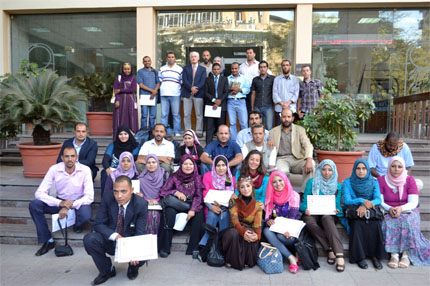
Some of the graduates and teachers of the Mit Rahina Beginners’ Field School. Photo by Saied Talbeah.
We then had the traditional photo sessions on the front steps of the Zamalek office. Amongst excited cries of ‘FS3 only’, ‘the Alex team here’ and ‘now the drawing team’, we took endless rounds of photos. After exchanging contact details and the web address for the field school group we said our good byes. Little by little small groups of students and teachers left for their homes and the Feast holiday (Eid el Adha).
… so like the palm date pickers of Memphis, at the end of the season we pack up and leave, with hope that we will be back again next season.

